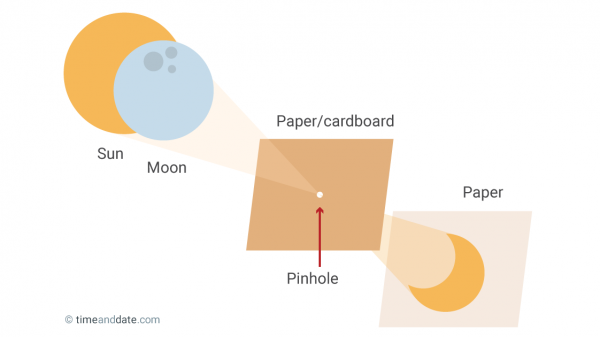
Should there be any adverse weather (clouds, storms, etc.) we will be hosting alternative viewing options and planned activities in the Calmar and Peosta Libraries.
Pinhole Camera/ Card Projector
Intro:
In case you don't have eclipse glasses or a sun-protected telescope to look at the sun directly, a pinhole camera can be used to project the eclipse onto a different surface for safe viewing.
Stay Safe!
Click THIS LINK to get a material and construction list for how to make a pinhole camera!

Experimenting with UV-sensitive Beads
By Deborah Scherrer, Stanford Solar Center
Intro:
Participants experiment with ultraviolet (UV) light-sensitive plastic beads, which are generally white but turn colors when exposed to UV light.
Learning Objectives:
After the activity, students/participants should understand that:
1. The Sun produces light in all wavelengths, including invisible ultraviolet (UV)
2. UV can be dangerous and can burn our skin, damage our eyes, and destroy our cells.
3. The Earth’s atmosphere provides significant, but not complete, protection from UV.
4. There are both ways to detect UV and also to protect ourselves from it.
Background:
These beads contain a special chemical that changes color when exposed to ultraviolet (UV) light. UV is an invisible type of light from the Sun. It can burn our skin and cause cancer, damage our eyes, and destroy our cells. Most UV is blocked by our Earth’s ozone layer and atmosphere, but some still get through and can be detected. The beads will stay white when inside or not exposed to UV. Incandescent and fluorescent lights will not affect them. They will only turn bright colors when exposed to UV, usually from the Sun or a UV (“black”) light. The darker the color of the beads, the more UV rays they are detecting. Once you bring the beads back indoors, they will (slowly) change to white again. This process can be repeated many times.
For the full packet experiment which includes UV charts, worksheet, materials needed, and more, click THIS LINK or download the PDF below.
Eclipse Soundscapes Observer Activity: How do solar eclipses affect animals & insects?
Intro:
The Eclipse Soundscapes Project is a NASA Citizen Science project funded by NASA Science Activation is studying how solar eclipses affect life on Earth during the 2023 annular eclipse and the April 8, 2024, total solar eclipse. Eclipse Soundscapes will revisit an eclipse study from almost 100 years ago that showed that animals and insects are affected by solar eclipses! Like this study from 100 years ago, ES will ask for the
public’s help. ES will also use modern technology to continue to study how solar eclipses affect life on Earth! We need the public’s help to gather as much observation data as possible! Eclipse Soundscapes is collecting multisensory observations from the April 8, 2024, total solar eclipse. The observations and sound data collected will help us understand the impact of the 2023 and 2024 solar eclipses on various U.S. ecosystems.
Information to help you out:
Latitude & Longitude: Calmar- 43.174317, -91.865208
Peosta- 42.445005, -90.846091 (outside the library) / 42.443903, -90.843490 (outdoor learning lab)
Location: Country (both campuses)
Eclipse Max: 2:03 pm
For the full packet including worksheets in English and Spanish CLICK HERE or download the PDF below.
Earth and Moon- to Scale
See the universe through a smaller lens with a demonstration brought to our level.
Using the standard-size globe of the Earth (about 12 inches) and a ball roughly the size of a baseball (about 3 inches) you'll have to have the two about 30 feet away.
Stellarium
Rain or Shine, look for signs of what library study room will have the Stellarium projection. This will give you a more digital view of the eclipse and what it will look like throughout the entire period without injuring your eyes.
This is a perfect option should you want to stop in for just a quick look between classes.
Small Talk
Some of our esteemed professors at both Calmar and Peosta Campuses plan on having quick stop-bys to offer fun facts and spectacular information on the eclipse and answer questions for those who have them. Student teachers visiting from Upper Iowa University will also make an appearance to impart their knowledge and gain lifelong experience in teaching this extraordinary topic.
Fun Facts gathered from the National Weather Service, Astronomy Magazine, NASA, NPR, and NASA: Highlights
A special thanks is due to the following for their amazing support, ideas, time, and help with putting this event together for our students, staff, faculty, and community to enjoy.
Dan Snyder
Victor Lieberman
Courtney Fagot
Germaine Kuhn
Geri Elsbernd
Marvin Ehm
Kathryn Gilbert
Kara Popp
John Bogdal
Matt Simon
Tim Folkerts
Jeremy Durelle
Terry Jenkins
Shannon Dirks
Chelsea Clegg
Katie Laux
Jacqueline Langreck